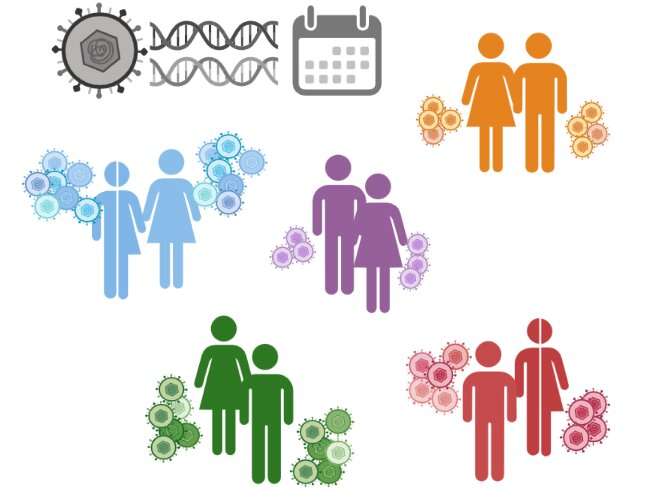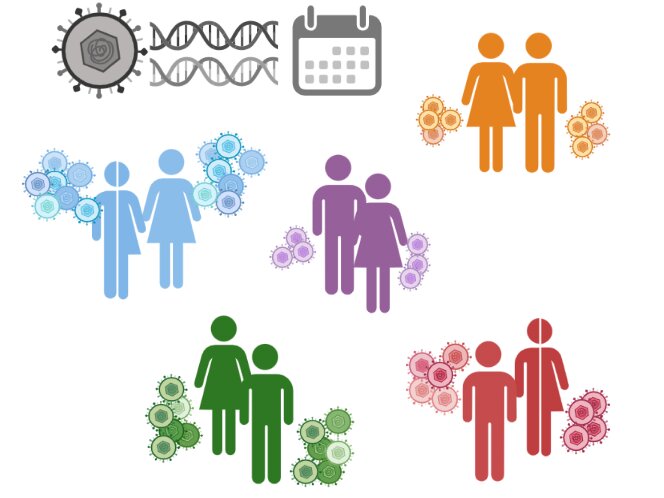
A new study helps explain how the virus that causes herpes might change during transmission between partners and over time during a long-term infection within a human host, which could have implications for future treatment strategies. The study, by a team of researchers from Penn State and the University of Washington, is the first to track genetic differences of the herpes simplex virus (HSV-1) as it moves between adult sexual transmission partners. Their findings revealed that viral population movement between partners has a strong impact on whether genetic differences appear at the start of new infections.
A paper describing this work appears online in the journal PLoS Pathogens.
“Hundreds of minor differences in the genome of HSV-1 have been documented around the world, and many of these differences—called variants—can be detected within a single human host,” said Molly Rathbun, graduate student in biochemistry and molecular biology at Penn State and the lead author of the paper. “How often these variants are transmitted and how quickly they evolve within a person has remained elusive until now. Improving our understanding of these processes might help us understand why individuals vary so much in the severity and frequency of their symptoms.”
Symptoms of HSV-1 include painful oral and/or genital lesions. The infection switches between two distinct stages. During the active stage, the virus replicates within skin cells, and newly produced virus is released, or “shed,” from the surface of the skin. Between active stages, the virus can remain dormant within sensory neurons. Transmission of HSV-1 occurs upon contact with the skin-surface of an infected area during periods of active virus shedding.
“This study focused on whole-genome sequencing of HSV-1, using samples donated by our study participants,” said Christine Johnston, associate professor in the Department of Medicine Division of Allergy and Infectious Diseases and associate medical director of the Virology Research Clinic at the University of Washington and an author on the paper. “This study is unique because we sampled participants within days to weeks after their first episode of genital HSV-1 infection, and we also sampled their partner who transmitted the disease to see if the virus had changed at all in the course of transmission.”
Like other viruses, HSV-1 can accumulate variation in its genome over time through mutation and other processes. After enough variants have accumulated the viral genome may eventually create a new “strain” of the virus.
“On average, HSV-1 genome sequences from unrelated infections vary by 1,500 to 4,000 variant positions—more than enough differences to create distinct strains,” said Rathbun. “Because variation at even one position can lead to significant changes in viral proteins, understanding how these differences emerge and are transmitted may have implications for treatment and future attempts to produce a vaccine.”
The researchers found that, when the viral population in the source partner was composed of only one strain, the viral genome was detected with near-perfect conservation in the corresponding recipient partner. When the viral population in the source partner was mixed, only some of the variants in that mixture were detected in the recipient partner’s infection. After transmission, the recipient partner’s infection might develop additional new variants in their viral population, leading to further differences between the transmission partners.
These findings suggest that HSV-1 genetic differences can be shuffled between each new infection if there is variation present in the source infection before transmission occurs. This phenomenon exposes a new angle as to how there are so many different strains of HSV-1 circulating around the world—each carrying subtle changes to the virus that can influence infection symptoms and severity.
“These data help to explain how viral diversity is transmitted between infections for this pathogen,” said Moriah Szpara, associate professor of biology and of biochemistry and molecular biology at Penn State. “It’s the first time we’re seeing the genetic results of transmission between unrelated adults with mixed viral populations.”
The authors used a direct-from-patient sampling approach to compare HSV-1 genomes collected on multiple sets of consecutive days and spanning an entire year. In doing so, they were able to track the growth and loss of viral variants that might have otherwise been missed.
“Some variants appeared to fluctuate within the viral population over time, which can be a sign of the virus responding to a new host environment,” said Szpara. “These variants will be important to explore in future work. The level of sensitivity we obtained with non-invasive skin sampling and targeted viral sequencing is an astonishing step forward in terms of viral detection. Many studies of HSV-1 have used samples cultured in the lab. By sequencing whole viral genomes directly from the skin surface, we can finally observe how viral populations change in actual human beings.”
The team also found evidence that in some cases, the viral variants detected within a person’s infection may collectively represent two distinct, co-existing HSV-1 strains. This finding contrasts with previous theories that HSV-1 mixtures reflect the slow accumulation of a collection of variants due to adaptation. While additional studies will be required to distinguish between these two possible explanations, the authors suggest that the mixing of strains could explain at least some of the HSV-1 diversity observed around the world.
“As we expand on these studies of viral population diversity in humans, we are aiming to understand how HSV’s genetic diversity enables the virus to escape host immunity. That kind of information might provide new insights for targeted drug development or new vaccination strategies,” said Szpara.
This study is also the first to compare HSV-1 genome sequences from individuals with ongoing oral and genital infections. Historically, oral herpes infections were dominantly caused by HSV-1, and genital herpes infections were caused by the related species, HSV-2. However, in recent decades, more new cases of genital herpes disease have been caused by HSV-1, especially in high-income countries.
“It is important to understand whether these changes are due to virologic factors, human behavior change, or both, to improve our strategies for prevention and treatment of genital HSV-1,” said Johnston.
Source: Read Full Article
